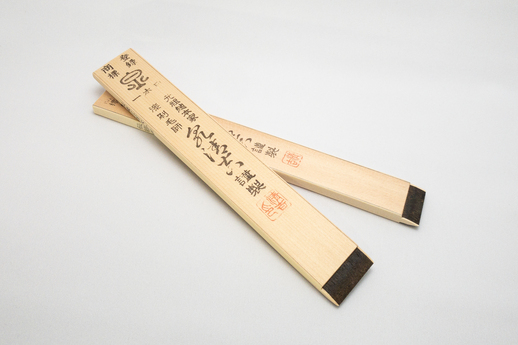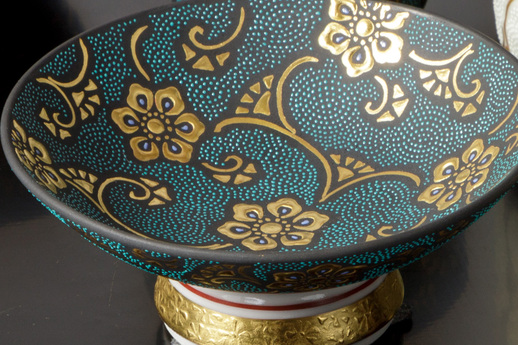2024.07.26
伝検通信(メルマガ)週刊メールマガジン「伝検通信」 第17号
週刊メールマガジン「伝検通信」第17号をお届けします。
今号のトップ記事は、宙ちゃんの「伝統文化一直線」 第9回 「技と美を支える道具たち」です。
「クイズで肩慣らし」は前回クイズの答え・解説と、陶磁器・ガラス分野からの出題です。
メルマガ登録した方の中から、抽選で100人に公式テキストをプレゼントするキャンペーンも引き続き実施中です! ぜひお近くの方にメルマガ登録をご案内ください。
伝検公式テキスト
https://bookpub.jiji.com/book/
目次
・ 宙ちゃんの「伝統文化一直線」 第9回 技と美を支える道具たち
・ 「クイズで肩慣らし」第17回(陶磁器・ガラス)=「彩色の技法」
・ 伝検協会だより
宙ちゃんの「伝統文化一直線」 第9回 技と美を支える道具たち
近藤宙時=日本伝統文化検定協会理事

泉清吉の漆刷毛(うるしばけ)
(https://www.torakichi-izumi.com/)
信長が築いた岐阜城を頂く金華山を背に、毎年5月から10月まで長良川で行われる鵜(う)飼い。闇に近い藍色の空間を、だいだい色のかがり火をたいた流線型の鵜舟が夜空を映した清流を下っていく光景は、まさに日本人の原風景の一つです。ただ、この幻想的な夏の風物詩が、実はあすをも知れぬほど危うい技術伝承の上に成り立っていることに、いったいどれほどの観光客が思いをはせているでしょうか。
一子相伝で1300年以上も鵜飼いの技術をつないできた鵜匠の存在自体が奇跡的ですが、彼らが乗る鵜舟はそれ以上に存続が危ぶまれています。今、鵜舟を造れる人はわずかに1組の親子だけ。鵜匠が操るウミウは、蛇の目の連続模様が美しい竹編みの鵜籠に入れますが、これもつい最近まで1人しか作れる人がいませんでした。
私たちの目を楽しませてくれる伝統工芸品の幾つかは、たとえ工芸師が腕を振るいたくても、あすも必ず作られる保証はない状況に置かれています。経済産業省が指定した「伝統的工芸品」は、1974年に制定された伝統的工芸品産業の振興に関する法律(伝産法)によって振興事業が行われています。しかしながら、対象となる工芸品を定義した同法第2条第1項1号には「主として日常生活の用に供されるものであること」とあるため、日常生活の用に供されない日本刀はもちろんのこと、制作に用いる伝統的な道具たちも国による振興策から除外されてきました。
例えば春慶塗(しゅんけいぬり)など、透き通る漆をはけ目も残さず鏡面のように塗るための漆ばけ。日本髪を結うときに使う「かもじ」(人毛で作った付け毛)の中でも、年数を経て脂分が抜けた古かもじを麦漆で固め、100年以上たった狂いの出ないヒノキの板で挟んだものです。普通のはけとは違い、毛が鉛筆のように板の末端まで通っており、必要に応じて板を削いで使います。人に見られることがない道具とあって何の装飾もありませんが、研ぎ澄まされた手仕事の気品が匂い立つような存在感。漆職人に使われ続けて短くなった漆ばけにも、長い間信頼され、愛され続けてきた物のみが持つ、誇らしげな凛(りん)とした風格があります。
また、和紙をすく時、すき舟(水槽)の中を前後左右に揺すられる簾桁(すけた)に挟まれた、極繊細な竹ひごを生糸で編んだ簾。とりわけ、カゲロウの羽に例えられる土佐典具帖紙(とさてんぐじょうし)をすくための簾の整然としたたたずまいは、美しさを誇るものではないだけに、ひそやかな可憐(かれん)ささえ感じさせます。
日本語には「縁の下の力持ち」という奥深い言葉があります。「いただきます」や「ごちそうさま」と同様、見えないものにも心を通わせる細やかな気遣いがにじみ出た表現です。伝統工芸の継承に欠かせない「縁の下の力持ち」である道具たちにも多くの人が心を寄せ、それらを駆使して生み出される匠の技と美にいつまでも触れられることを願ってやみません。
「クイズで肩慣らし」第17回(陶磁器・ガラス)=「彩色の技法」
~伝検公式テキスト(9月20日先行発売予定)のジャンルごとに出題します~

伝統工芸士・仲田錦玉による「酒盃」
第17回
問題:大正時代に始まったといわれる九谷焼の彩色技法の一つで、イッチンという特殊な道具・技法を使って丸い点を描く、写真に見られるような上絵の盛り上げ技法は何というでしょう。
【前回の答えと解説】
問題:世阿弥が確立した能の劇形式で、「井筒」などに代表される神霊や過去の幽霊など霊的な存在が主人公となる形式を「( )能」と言います。( )に入る言葉は何でしょう。
答え:夢幻(むげん)
解説:能は大きく「現在能」と「夢幻能」に分けられます。生きた人間のドラマを現在進行形で描くのが「現在能」。一方、「夢幻能」は神や鬼、幽霊といった異界からやって来た霊的存在が昔を思い、その土地にまつわる伝説を振り返ったり、過去の物語を再現したりするのが特徴です。人間の心理を深く描き出せる「夢幻能」は、世阿弥が父の観阿弥が志した幽玄を受け継いで確立した劇形式です。
伝検協会だより
東京・銀座のビルの屋上で育てた楮(こうぞ)を原料にした「銀座和紙」をテーマとするシンポジウムに先日、参加しました。水墨画家の小林東雲氏による実演では、銀座和紙を含む三つの異なる和紙に、木を題材にしたほぼ同じ絵柄を描き、墨のかすれやにじみ具合の違いをチェック。その作品では、丸い月を書き加えたり、枝に積もった雪を描いたりして、秋や冬といった季節を描写。筆のわずかな動きや墨の濃淡で季節感を表現する技法は圧巻でした。
編集後記
伝検通信第17号はいかがでしたか。伝統工芸を支える道具の作り手がいなくなりつつあるという「宙ちゃん」の指摘は衝撃でした。人口減少社会のインパクトはよく語られますが、働き手が足りないことに加えて、技術の継承もままならなくなることまで思いが至りませんでした。AIがいくら発達しても、こればかりは人の手で作り、継承していかないといけません。 さまざまな教育機関で継承することも有効と思います。
カテゴリー: 伝検通信(メルマガ)





